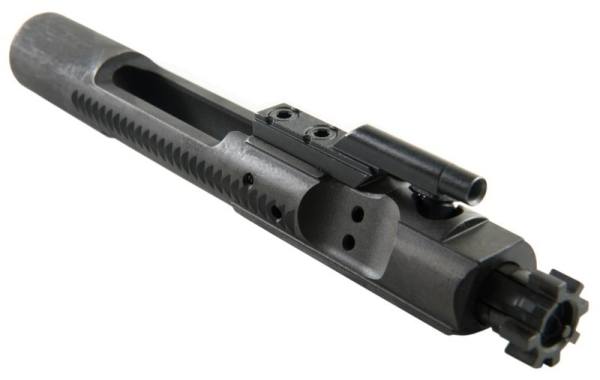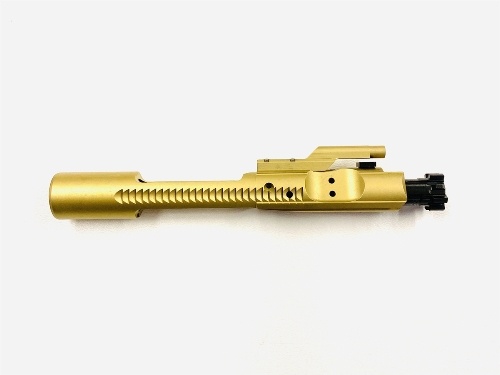Finding the right bolt carrier group coatings can be quite challenging if you do not have an understanding of your AR-15 and the features of the coating material.
We may not be able to help you with the former, but read this Bolt Carrier Group Coatings: What’s the Difference? article to find the right upgrade for your defense tool!
Contents
Bolt Carrier Group Coatings: What’s The Difference?
#1. Phosphate Coat
This method of coating is known commonly by a list of different names, such as “manganese phosphate coating”, “phosphating”, and “parkerizing”. Upon first glance, it might look like the coating on your granny’s old arm back in WWII, but that’s actually zinc phosphate that’s harder to use!
To apply the manganese phosphate coat, mechanics place the bolt carrier group in acid – specifically the phosphoric kind – and introduce at least 200℉ to the pot. This allows a chemical reaction to happen, and the result is a layer of manganese phosphate to appear on the part submerged in acid!
The reason why phosphate coating stays at the top of any list you find is its popularity, durability, and low usage difficulty level. You can spot military and government-use firearms being protected with this method.
Bolt carrier groups covered in phosphate coatings generate a lot more friction than other methods. So if you avoid spending on coatings, you’re gonna have to use that money to buy lube anyway.
Phosphate coatings are also quite challenging to get grimes off and require a lot more maintenance than other types of coatings on this list.
#2. Nickel Coat
Next on this list is the plethora of nickel coatings. Thanks to nickel’s flexibility, there are quite a lot of variants of nickel coatings with slightly different characteristics, such as nickel boron, nickel boron nitride, and even NP3!
The applying method for this kind of bolt carrier group coatings is a tad less simple than before. The bolt carrier group has to go through a procedure called electroless nickel plating that uses the metal on the part itself to deliver an even layer of coating!
After the chemical process has ended, you will have a bolt carrier group that produces near-to-zero friction during its use. By solving this drawback of phosphate coating, nickel and nickel-variant coatings are easy to polish and do not call for the use of lubrication.
Nevertheless, since the plating process is much more difficult to execute, the end product costs more and doesn’t withstand as well against the elements. Nickel coatings are definitely more susceptible to rust, so the beautiful silver color does not stay for long on your devices.
#3. Nitride Coat
You may have heard of nitride coating and its many types before. Melonite, QPQ, tenifer, isonite, so on and so forth are all the same substances with a little twist to form the nearly identical result on your parts.
A great thing about using nitride coatings in your gears is the application process actually strengthens the steel of the part, so there’s considerably less possibility of the finished product breaking into flakes. The coated parts’ hardness can be up to 64 HRC with no risk of increased thickness at all!
Nitride coatings are effortless to clean and apply, too. They’re especially profitable when applied in large quantities, so if you want to replace your current group with a premade nitride-coated version, it might be even cheaper than a phosphate-coated group!
#4. Titanium Nitride Coat
Coatings that belong to the Titanium nitride group are not like the kind we’ve mentioned before; that is why it needs another paragraph on its own. This coating requires a different chemical procedure called vapor deposition, which will end up making a different end product with a different golden gloss!
Having a titanium nitride coating is very expensive, but in turn, you’ll get a pretty-looking, increasingly durable coating. Titanium Nitride coats are also easy to stay hygienic.
#5. Other Coatings
There are a lot of other coatings with distinct characteristics that will fit your needs. Please consult the list below:
- Diamond-like Carbon (DLC)
- Robar NP3+
- Chrome
Please do careful research before you wish to commit to any kind of coatings for your bolt carrier group. And should you have any questions, don’t hesitate to ask for more information from the manufacturer or the distributor of the part!
Final Thought
To conclude this “Bolt Carrier Group Coatings: What’s the Difference?” article, you should not choose the unsuitable bolt carrier group coatings just to save a bit of money, as it is the component that allows your firearm to work properly. Quality on the coats is just as important as quality on the AR-15 itself!

I am Jerry Gonzalez, and my heart beats for the great outdoors, especially in the breathtaking landscapes of Helena, Montana. Engaging with fellow enthusiasts online and at local hunting clubs has been a rewarding experience, and I find great joy in sharing knowledge and experiences with like-minded individuals. My goal is to empower my fellow hunters with well-informed choices, regardless of their experience level.



